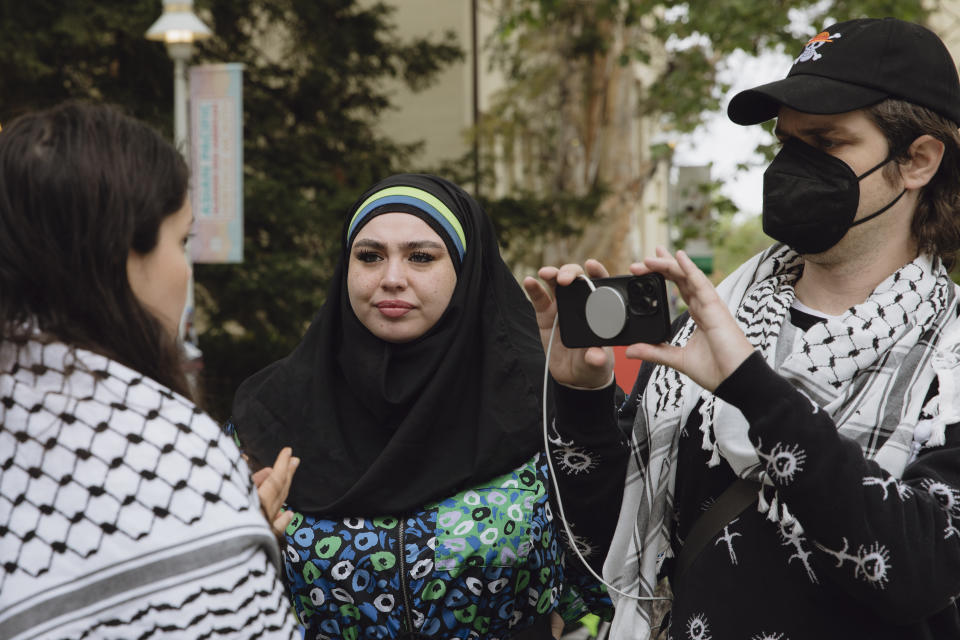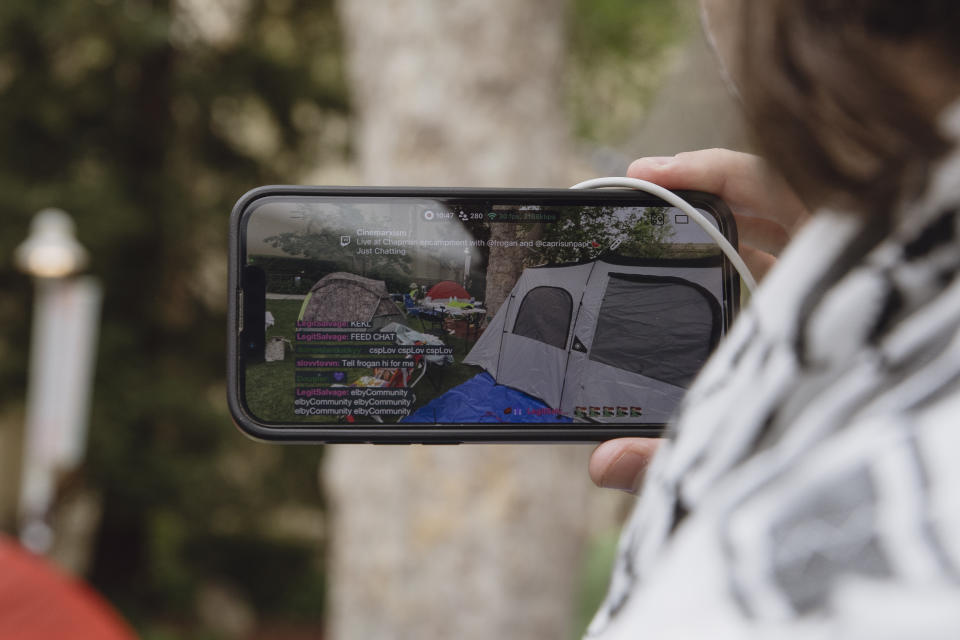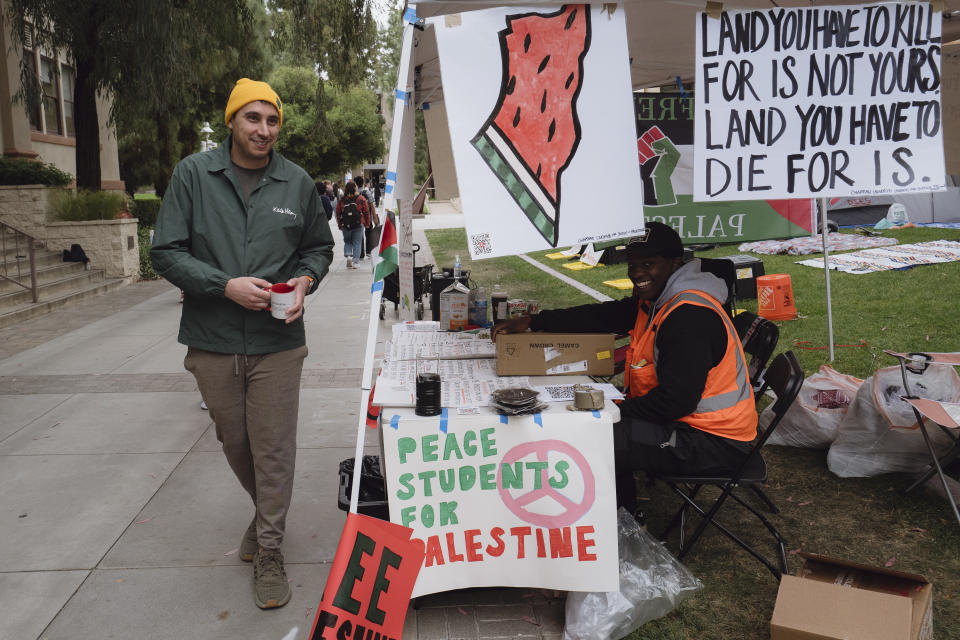Twitch streamers become go-to news source for campus protest coverage
As hundreds of police officers descended on UCLA’s campus last week, Bret Hamilton, a 31-year-old Twitch streamer who covers news and politics, documented their every move. He trailed the officers as they barreled their way through pro-Palestinian student protesters who were protecting an encampment at the center of the campus. Thousands of people watched Hamilton’s stream live as he narrated the chaos.
“People don’t trust the media to tell the truth about these things,” he told The Washington Post.
Hamilton is one of a growing number of professional live-streamers who have been covering the student protests on college campuses. These streamers, who operate on platforms that include TikTok and YouTube, but primarily Twitch, make up an alternative media network, not unlike cable news, with round-the-clock coverage of major protest developments, negotiations between students and administrators, and police crackdowns. Their streams provide an unfiltered account of the protests and have become a go-to source for thousands of young people who have lost faith in traditional news.
Twitch wasn’t always a place for news and political content. For years, content creators on the live-streaming app focused primarily on gaming and eschewed politics over fears that discussion of such topics would alienate viewers. But that culture changed in part after Hasan Piker, a progressive political commentator who had become a Facebook video star and gone viral as the internet’s “woke bae” joined the platform in 2018 and quickly rose to become one of the most popular creators.
His hours-long streams offering political analysis and breaking down major news events began attracting a large audience of Gen Z and young millennial followers, who found his candid, frenetic style more appealing than more formal news anchors and mainstream reporters.
“There’s a huge need and huge demand for real-time journalism happening on the ground,” Piker said. “I see myself as a command center when live-streaming. When I’m not on the ground myself, I try to find others who are.”
Since the Black Lives Matter protests in 2020, live-streamed protest coverage has become increasingly easy to find on Twitch. When major news breaks or when a large protest kicks off, there are almost always a few streamers covering it.
“Twitch has always been a place for conversation, including around current events,” a spokesperson for the company said. “We continue to see streamers use Twitch to connect with their communities in real time, and that makes our service unique.” (Twitch is owned by Amazon, whose founder and executive chairman, Jeff Bezos, owns The Washington Post.)
Approximately 35 million users visit the streaming platform daily, watching approximately 7 million Twitch streamers who go live every month, according to the company. In April, Twitch users watched 1.6 billion total hours of content on the platform, according to StreamElements, which provides tools that help creators monetize their content.
Many of those streamers, like CapriSunnPapi, a Palestinian content creator in Los Angeles who asked to be referred to by his Twitch username for privacy reasons, have pivoted from nonpolitical content to covering the war in Gaza since the Oct. 7 Hamas attacks that killed as many as 1,200 Israelis.
“I wasn’t doing news at all before October,” he said. He used to produce a “reality-TV-style game show” on Twitch, where he’d do stunts like putting 100 people together on a Zoom call and giving money to the last person to leave.
Since shifting to news, CapriSunnPapi has visited various campus student encampments to provide firsthand coverage. Unlike journalists from traditional outlets, streamers have been largely welcomed in campus encampments.
“Streamers are going in deeper than the media is,” he said.
When a group of Twitch streamers visited the encampment at Chapman University in Orange, Calif., on Friday, Yness Riedel, a student organizer, greeted them with praise and gratitude. “You do not comprehend how thankful we are that you guys are here, because you guys have such an impactful platform,” she said.
Piker said that part of this dynamic is due to trust these content creators have built among the protesters. Twitch streamers have no problem working with media liaisons representing the demonstrators, for instance; some in traditional media report less welcoming interactions.
“[The media] loves talking to PR people when it comes to corporations,” Piker said. “They have no problem talking to the media liaison when it comes to the NYPD or the LAPD and writing down everything they say without even asking remotely contentious questions. But when it comes to students, they don’t treat these students as an organized entity at all.”
The streamers covering various protests often tune in to each other’s streams while on the ground to see where the others are located and where the action is. They receive real-time feedback and information from the chats on their streams, too. Sometimes members of the chat will give streamers background information on people they encounter while out doing their coverage, or direct them to go to certain areas.
Morgan, a 27-year-old Twitch streamer in Los Angeles who posts under the handle Fr0gan and who asked to be referred to by her first name only for privacy reasons, said that she was out covering the UCLA protests to correct the narratives about pro-Palestinian groups she was seeing on traditional news. She often includes news content between reports on more general-interest topics, such as gaming, on her channel.
“We get people [on stream] who typically wouldn’t have a voice in the mainstream media,” she said. “When you look at major outlets, they quite frankly don’t really elevate Palestinians’ voices. They do everything they can to villainize Palestinians. Whereas most Twitch streamers are doing quite the opposite, showing the actual history and backing it up with facts.”
Morgan said that growing up as a Muslim woman, she didn’t see people with her worldview or background represented much but that Twitch has allowed her to find others who are like-minded.
When Morgan saw Hamilton streaming from the encampment at UCLA last week, she “stream sniped” him, meaning that she watched his stream to determine his location, and then went to stream alongside him. Later on, CapriSunnPapi joined the duo.
While most fans of Twitch streamers are young, Tofugh0st, a Twitch streamer who covers music, politics and gaming on her channel and asked to be referred to by her Twitch tag for privacy reasons, said that recently, older viewers have been tuning in. “It’s very apparent that there are older people coming to Twitch, which is really, really cool and interesting,” she said.
The Twitch streamers at protests often work alongside First Amendment advocates and so-called “cop watchers” who regularly film the police in an effort to bring more accountability to police departments.
William Gude, a finance worker who runs Film the Police LA and is a leader in the Los Angeles community dedicated to monitoring police actions, said that he, too, has come to embrace live-streaming in the past year, though he primarily does so on YouTube.
“It’s important to get information out as quickly as possible,” he said. “It’s important for people to see what’s happening in full context, and I think only a live-stream can do that properly. It’s one thing to take a journalist’s opinion on something versus raw video in real time.”
Tofugh0st said that consuming Twitch live-streams of protests herself has made her more skeptical of traditional media. “Watching the juxtaposition between the two types of media is staggering,” she said. “It’s drastic … I think that it is a really perfect example of why people are leaving traditional media and going into these new forms of media.”
Sebastian Cazares, a 23-year-old UCLA graduate student in public policy, said that he was grateful for the Twitch streamers’ coverage of the events on campus. “It’s a new type of digital journalism. It’s creating a new medium,” he said.
The medium is proving successful. Hamilton said that his audience has doubled in recent weeks as he moved to cover the protests. Others report similar gains. “My numbers have jumped up substantially from this,” said CapriSunnPapi.
“I’ve grown from it, but that was really never the intention. I thought I was only going to be talking to 150 people, but last night I was streaming to thousands.”
Related Content
Why Highway 1 is the climate challenge that California can’t fix
Trump advisers explore vast new legal powers for global trade war
DEI is getting a new name. Can it dump the political baggage?




